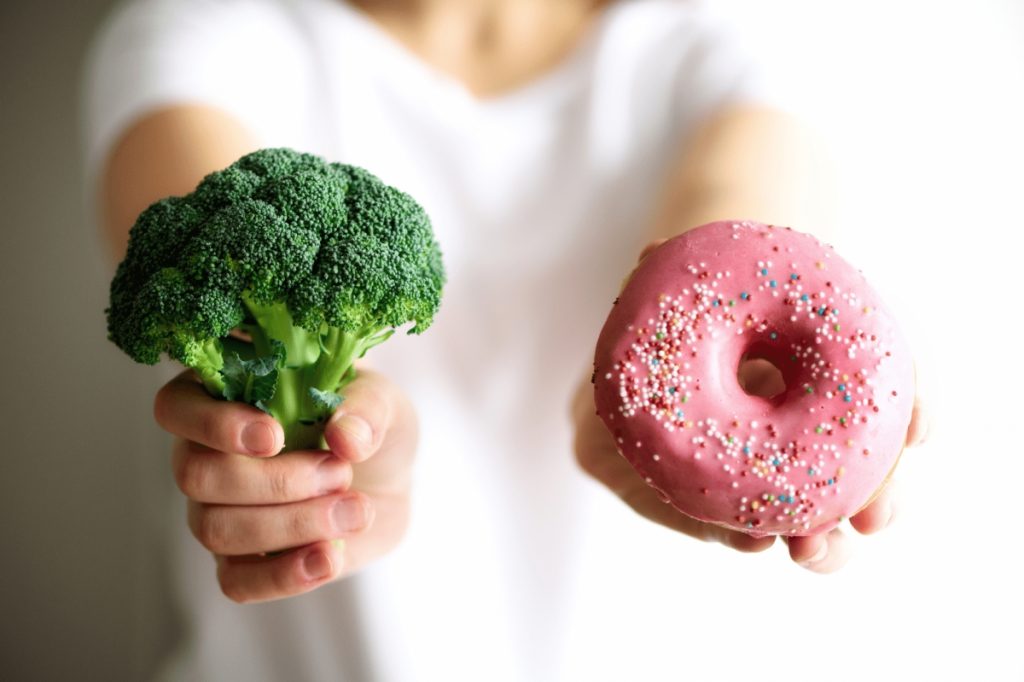Part 2: Foods That Cause And Help With Hormone Imbalances For Women
A hormonal imbalance with too much or too little of a hormone can profoundly affect your health and well-being. Without knowing it, you may be making it worse with what you are or are not including in your diet.

In Part 1, we discussed the many physical factors that can cause hormone imbalances. In this article, Part 2, let’s turn to some things that you can control daily: your food intake. First, we’ll start with some foods that cause hormonal imbalances.
Foods That Cause Hormone Imbalances In Women

Soy
The typical American diet is inevitably high in soy from various sources:
- Various processed foods
- Flours
- Protein powders
- Meat alternatives
The safety of soy is highly debated in the field of women’s health from a phytoestrogen perspective and its effect on women’s hormone health. In a recent 2022 comprehensive review of studies on the effects of soy in women, researchers found that eating a lot of soy may reduce the ovarian synthesis of estrogen. High soy consumption may also slightly negatively affect:
- The hormonal network
- Menstrual cycle length
- Fertility outcomes
In contrast, soy may help endocrine diseases such as PCOS and fertility treatments.
We know for certain that over 90% of soybeans produced in the United States are genetically modified. The problem with genetically modified foods is that almost all soybeans are glyphosate-tolerant, meaning that they are made to withstand heavy doses of this herbicide, a known toxic hormone disruptor. If you eat non-organic soy products, you’ll inevitably eat some glyphosate.
A study review of the use of glyphosate in soybeans found that farmers doubled the use of glyphosate on glyphosate-resistant soybeans resulting in increased residue in soy products. Soybean farms in just three countries (United States, Brazil, and Argentina) use a total of 2,500 – 10,000 metric tons of glyphosate per year, which then gets into your food supply.
If you choose to consume soy, it’s extremely important to choose organic and avoid genetically modified soy. It’s also safer to stick to fermented, probiotic-rich forms of soy like tempeh, natto, miso, and tamari.
Charred And Processed Meat
Part of the estrogen balancing process includes eliminating estrogen from your body. When this goes wrong, toxic forms of estrogen can build up in your body, causing symptoms of hormone imbalances. Toxic estrogen metabolites may also increase the risk of breast, endometrial, and prostate cancers
Before elimination via your urine or feces, your liver converts estrogen into inactive metabolites. The catalyst in the first step of estrogen metabolism is cytochrome P450 (CYP) enzymes.
Charred and processed meat may contain substances that prevent the CYP enzymes from doing their job. These include polycyclic aromatic hydrocarbons and heterocyclic amines, among others. These components can interfere with estrogen detoxification, act as a xenoestrogen, or initiate other potentially cancer-causing activities.
In a study of 578 postmenopausal women, researchers compared subjects’ food intake to their estrogen levels. Women following a Western diet (typically higher in red and processed meats) also had higher estrogen levels than those consuming lower amounts.
Beyond estrogen metabolism, non-organic meats can also cause unhealthy estrogen levels in your body by increasing your exposure to estrogen. Cattle raised for human consumption are sometimes implanted with hormones to increase the amount of muscle they produce.
In a study examining the estrogen levels in beef, researchers compared beef fat from the United States and Japan. The estrogen levels in US beef were 14 picograms per gram, while Japanese beef did not have any detectable estrogen. While these amounts in and of themselves are not incredibly high, consumption over time may be a factor in raising your own estrogen levels.
To avoid an unhealthy increase in estrogen and keep your hormones balanced, it’s better to avoid non-organic red meat and processed meats.
Despite these links and some epidemiologic studies linking red meat to cancer, the evidence of red meat remains inconclusive. The International Agency for Research on Cancer concluded that red meat is probably carcinogenic. Whereas, processed meat such as smoked and cured meats are definitely carcinogenic.
Red meat can still be a healthy source of protein, iron, zinc, and good fats, especially if:
- The meat is cooked gently, with minimal charring or smoke exposure.
- The meat comes from an organic, or a natural and hormone-free source.
- The meal also includes hormone-balancing foods, such as vegetables and fibers.
- Your toxic estrogen metabolites, such as in the DUTCH test, remain in healthy ranges given the frequency you consume red meat. This depends on many factors, including your genetics and toxic load.

Junk Food
Junk food is generally optimized for the food companies’ profits. That means they use non-organic ingredients and all kinds of fillers, including soy. Non-organic and industrially-grown meats in the US may contain extra hormones and pesticides. The food also tends to be low in fiber and micronutrients while high in unhealthy fats, sugar, and other unhealthy flavorings.
These foods also tend to be packaged or have been packaged in plastics and styrofoam. Plastic packaging and styrofoams can release building blocks that are hormone disruptors into the food, especially if the food is greasy and hot.
Junk food is not healthy for numerous reasons, with the potential to cause hormone imbalances being one of them.
Sugar And Foods That Throw Off Blood Sugar
When you think about the negative effects of sugar, you may be thinking about weight gain, but it goes beyond just that. Wild blood sugar fluctuations, insulin resistance, and poor blood sugar control can cause hormone imbalance. Women with insulin resistance are more likely to have the following:
- Higher testosterone levels
- Higher cortisol levels
- Lower estrogen levels
The imbalance of the above hormones and insulin resistance are also linked to higher rates of polycystic ovary syndrome (PCOS). About 70% of women with PCOS are insulin resistant. Researchers also believe that high testosterone levels are a key contributing factor. Symptoms of PCOS include:
- Acne
- Weight gain
- Irregular periods
- Fertility issues
- Excessive body and facial hair
- Depression
Insulin resistance is also a key contributing factor to acne in all genders, even without PCOS.
Nutritionists used to think that high-glycemic impact foods were the problem. However, more recent research shows that blood sugar responses to each food is very individual. Chronic inflammation can also contribute to insulin resistance
The key is that you want to be on a diet and lifestyle that keeps your blood sugar stable. Generally, if you’re healthy and your blood sugar is well-controlled, you may be able to enjoy carbs and sugar occasionally without throwing off your hormones. Blood Sugar Breakthrough can also dampen the health effects of these occasional treats.
But if you’re struggling with your hormones and weight gain, it might be best to avoid high-carbs and high-sugar foods such as:
- Bread
- Pasta
- Rice
- Desserts
- Candies
- And pastries
If you suspect your blood sugar might be an issue, consult an integrative doctor to check for insulin resistance and work toward improving your blood sugar control.
Caffeine
Starting your day off with a cup of joe or a mug of tea is delicious and satisfying, but it also might affect your estrogen levels. How much caffeine affects your estrogen levels tends to vary based on race.
A study of 259 black, white, and Asian premenopausal women explored the relationship between estrogen levels and caffeine intake for two menstrual cycles. High caffeine intake (greater than 200 mg per day) led to decreased estrogen levels in white women and increased estrogen levels in Asian and black women.
Researchers believe that the varied reactions to caffeine based on race may be due to how caffeine is metabolized. People of Asian and African descent tend to metabolize caffeine more slowly. they don’t break down and eliminate estrogen as quickly, making high estrogen levels more likely.
Foods That Help With Hormone Imbalances In Women
Now that you know what foods to look out for and avoid, let’s focus on what can help keep your hormones balanced.
Cruciferous Vegetables

Part of maintaining hormonal balance is ensuring that you are properly metabolizing and detoxifying estrogen so it doesn’t build up. Cruciferous vegetables support this process to detox the excess hormones in the liver.
Cruciferous vegetables are a part of the Brassica family and include:
- Broccoli
- Cauliflower
- Cabbage
- Kale
- Garden cress
- Bok choy
- Brussel sprouts
- Radish
- Mustard greens
These vegetables contain diindolylmethane (DIM), a phytochemical that shifts estrogen metabolism. DIM promotes the conversion of estrogen into a less inflammatory metabolite.
Cruciferous vegetables also help support liver health which in turn helps support the estrogen detoxification process. They contain a sulfur compound called sulforaphane that helps protect the liver from toxins released during the first phase of hormone metabolism.
Fibers
High-fiber diets help lower estrogen levels and provide possible protection against cancers associated with high estrogen levels, such as breast cancer. Researchers believe fiber lowers estrogen levels by increasing the amount of estrogen excreted through your bowel movements.
In a study of 250 menstruating women, researchers examined the effect of dietary fiber hormone levels across two menstrual cycles. Those who consumed more fiber at or above 22 grams daily had lower estrogen levels. Therefore, a high-fiber diet benefits those wishing to decrease estrogen levels.
Legumes
To reap all of the health benefits of phytoestrogens while avoiding the controversy regarding soy consumption, focus your eating on other legumes. Some of the most common legumes include:
- Peas
- Lentils
- Beans
- Peanuts
- Chickpeas
Legumes help balance your hormones by increasing estrogen levels and acting on your estrogen receptors. This is helpful to support your body during your menstrual cycle when your estrogen levels naturally drop and relieve some discomfort.
A compound in legumes called isoflavones helps reduce hot flashes in menopausal women. Because phytoestrogens act similarly to estrogen in the body, it can cause the body to decrease its natural estrogen production and provide you some relief.
While it may seem a bit confusing that phytoestrogens can both increase and decrease estrogen, to put it more simply:
- Eating smaller amounts of phytoestrogens acts like estrogen and increases your overall levels.
- When you eat phytoestrogens in large amounts, they can block estrogen and reduce your overall levels.
Wild-Caught Fish

Your body requires essential fatty acids, omega-3s in particular, to produce your sex hormones. One of the best sources of omega-3s is wild-caught fish. Some of the highest sources are:
- Mackerel
- Salmon
- Herring
- Sardines
- Anchovies
Omega-3s also help:
- Transport your hormones
- Make hormone receptor sites more sensitive
They also help prevent two hormone-disrupting concerns we discussed earlier – inflammation and poor blood sugar control.
While farmed fish also contain omega-3s, choosing wild-caught fish allows you to avoid the benefits without exposure to contaminants such as antibiotics, pesticides, and other toxic chemicals.
Organic And Wild-Caught Meat And Organ Meats
Choosing the right kind of meat is an important factor in maintaining hormonal balance. The best choices are organic, wild-caught meat, and organic meats.
When you choose organic and wild-caught meat, you immediately decrease your exposure to the pesticides and hormones found in conventional meat. You also win from a nutritional standpoint.
In a meta-analysis comparing the nutritional content of conventional meat to organic meat, researchers found one major difference: organic meat contains more hormone-balancing omega-3s than conventional meat.
An animal study comparing the effects of consuming conventional versus organic chicken on rats examined the sex hormone levels after six weeks. Those who ate conventional chicken experienced hormonal imbalance, while the ones who ate organic chicken did not.
Eating organ meats nourishes your body and supports hormone balance. Organ meats are a nutrient-dense option to get critical vitamins and minerals into your diet. They contain the critical vitamins we discussed earlier, such as:
- Vitamin A
- B Vitamins
- Vitamin D
Organ meats also contain selenium, a critical mineral for thyroid health, and to help support estrogen balance.
The Takeaway
Hormone imbalance may be the culprit for multiple health complaints in women. Making sure you avoid the wrong foods and boosting your diet with the right foods may be just what you need to keep your hormones in balance. Some steps to take are:
- Avoid Soy
- Eat some non-soy legumes in reasonable amounts
- Limit your intake of junk food and sugar
- Pay attention to your hormonal response to caffeine
- Increase your Omega-3s with wild-caught fish and organic meat
- Eat more cruciferous vegetables
- Increase fiber to reduce estrogen levels
- See an integrative practitioner regularly to check your hormones with a functional lab test, such as the DUTCH test.
- Rizzo G, Feraco A, Storz MA, Lombardo M. The role of soy and soy isoflavones on women’s fertility and related outcomes: an update. J Nutr Sci. 2022;11(e17):e17. doi:10.1017/jns.2022.15
- Dodson L. Recent trends in GE adoption. Usda.gov. Accessed February 1, 2023. https://www.ers.usda.gov/data-products/adoption-of-genetically-engineered-crops-in-the-u-s/recent-trends-in-ge-adoption/
- Bøhn T, Millstone E. The introduction of thousands of tonnes of glyphosate in the food chain-an evaluation of glyphosate tolerant soybeans. Foods. 2019;8(12):669. doi:10.3390/foods8120669
- Gasnier C, Dumont C, Benachour N, Clair E, Chagnon MC, Séralini GE. Glyphosate-based herbicides are toxic and endocrine disruptors in human cell lines. Toxicology. 2009;262(3):184-191. doi:10.1016/j.tox.2009.06.006
- Fuhrman BJ, Schairer C, Gail MH, et al. Estrogen metabolism and risk of breast cancer in postmenopausal women. J Natl Cancer Inst. 2012;104(4):326-339. doi:10.1093/jnci/djr531
- Brinton LA, Trabert B, Anderson GL, et al. Serum estrogens and estrogen metabolites and endometrial cancer risk among postmenopausal women. Cancer Epidemiol Biomarkers Prev. 2016;25(7):1081-1089. doi:10.1158/1055-9965.epi-16-0225
- Barba M, Yang L, Schünemann HJ, et al. Urinary estrogen metabolites and prostate cancer: a case-control study and meta-analysis. J Exp Clin Cancer Res. 2009;28(1):135. doi:10.1186/1756-9966-28-135
- Tsuchiya Y, Nakajima M, Yokoi T. Cytochrome P450-mediated metabolism of estrogens and its regulation in human. Cancer Lett. 2005;227(2):115-124. doi:10.1016/j.canlet.2004.10.007
- IARC Working Group on the Evaluation of Carcinogenic Risks to Humans. 4. Mechanistic and Other Relevant Data. International Agency for Research on Cancer; 2018.
- Fung TT, Hu FB, Barbieri RL, Willett WC, Hankinson SE. Dietary patterns, the Alternate Healthy Eating Index and plasma sex hormone concentrations in postmenopausal women. Int J Cancer. 2007;121(4):803-809. doi:10.1002/ijc.22728
- Handa Y, Fujita H, Watanabe Y, et al. Does dietary estrogen intake from meat relate to the incidence of hormone-dependent cancers? J Clin Oncol. 2010;28(15_suppl):1553-1553. doi:10.1200/jco.2010.28.15_suppl.1553
- Domingo JL, Nadal M. Carcinogenicity of consumption of red meat and processed meat: A review of scientific news since the IARC decision. Food Chem Toxicol. 2017;105:256-261. doi:10.1016/j.fct.2017.04.028
- Endocrine disruptors. National Institute of Environmental Health Sciences. Accessed February 1, 2023. https://www.niehs.nih.gov/health/topics/agents/endocrine/index.cfm
- Patel SM, Ratcliffe SJ, Reilly MP, et al. Higher serum testosterone concentration in older women is associated with insulin resistance, metabolic syndrome, and cardiovascular disease. J Clin Endocrinol Metab. 2009;94(12):4776-4784. doi:10.1210/jc.2009-0740
- Stolk RP, Lamberts SW, de Jong FH, Pols HA, Grobbee DE. Gender differences in the associations between cortisol and insulin in healthy subjects. J Endocrinol. 1996;149(2):313-318. doi:10.1677/joe.0.1490313
- Suba Z. Interplay between insulin resistance and estrogen deficiency as co- activators in carcinogenesis. Pathol Oncol Res. 2012;18(2):123-133. doi:10.1007/s12253-011-9466-8
- Moghetti P. Insulin resistance and polycystic ovary syndrome. Curr Pharm Des. 2016;22(36):5526-5534. doi:10.2174/1381612822666160720155855
- Sadowska-Przytocka A, Gruszczyńska M, Ostałowska A, et al. Insulin resistance in the course of acne – literature review. Postepy Dermatol Alergol. 2022;39(2):231-238. doi:10.5114/ada.2021.107101
- Shoelson SE, Lee J, Goldfine AB. Inflammation and insulin resistance. J Clin Invest. 2006;116(7):1793-1801. doi:10.1172/JCI29069
- Schliep KC, Schisterman EF, Mumford SL, et al. Caffeinated beverage intake and reproductive hormones among premenopausal women in the BioCycle Study. Am J Clin Nutr. 2012;95(2):488-497. doi:10.3945/ajcn.111.021287
- Rhyu J, Yu R. Newly discovered endocrine functions of the liver. World J Hepatol. 2021;13(11):1611-1628. doi:10.4254/wjh.v13.i11.1611
- Yoshida K, Ushida Y, Ishijima T, et al. Broccoli sprout extract induces detoxification-related gene expression and attenuates acute liver injury. World J Gastroenterol. 2015;21(35):10091-10103. doi:10.3748/wjg.v21.i35.10091
- Farvid MS, Eliassen AH, Cho E, Liao X, Chen WY, Willett WC. Dietary fiber intake in young adults and breast cancer risk. Pediatrics. 2016;137(3):e20151226. doi:10.1542/peds.2015-1226
- Gaskins AJ, Mumford SL, Zhang C, et al. Effect of daily fiber intake on reproductive function: the BioCycle Study. Am J Clin Nutr. 2009;90(4):1061-1069. doi:10.3945/ajcn.2009.27990
- Howes LG, Howes JB, Knight DC. Isoflavone therapy for menopausal flushes: a systematic review and meta-analysis. Maturitas. 2006;55(3):203-211. doi:10.1016/j.maturitas.2006.03.008
- FoodData central. Usda.gov. Accessed February 1, 2023. https://fdc.nal.usda.gov/fdc-app.html#/food-details/168149/nutrients
- FoodData central. Usda.gov. Accessed February 1, 2023. https://fdc.nal.usda.gov/fdc-app.html#/food-details/175168/nutrients
- FoodData central. Usda.gov. Accessed February 1, 2023. https://fdc.nal.usda.gov/fdc-app.html#/food-details/173668/nutrients
- FoodData central. Usda.gov. Accessed February 1, 2023. https://fdc.nal.usda.gov/fdc-app.html#/food-details/175139/nutrients
- FoodData central. Usda.gov. Accessed February 1, 2023. https://fdc.nal.usda.gov/fdc-app.html#/food-details/174183/nutrients
- Saldeen P, Saldeen T. Women and omega-3 fatty acids. Obstet Gynecol Surv. 2004;59(10):722-730; quiz 745-746. doi:10.1097/01.ogx.0000140038.70473.96
- Chen C, Yu X, Shao S. Effects of omega-3 fatty acid supplementation on glucose control and lipid levels in type 2 diabetes: A meta-analysis. PLoS One. 2015;10(10):e0139565. doi:10.1371/journal.pone.013956
- Kipp-Sinanis E. Enviromental Impact of Aquaculture Wild-Caught vs Farmed Fish. Published online 2011. Accessed February 1, 2023. https://www.researchgate.net/publication/324165259_Environmental_Impact_of_Aquaculture_Wild-Caught_vs_Farmed_Fish
- Średnicka-Tober D, Barański M, Seal C, et al. Composition differences between organic and conventional meat: a systematic literature review and meta-analysis. Br J Nutr. 2016;115(6):994-1011. doi:10.1017/S0007114515005073
- Ahmad S, Ahmed I, Haider S, Batool Z, Ahmed SB. Daily consumption of commercial chicken feed and meat lead to alterations in serum cholesterol and steroidal sex hormones in female rats. Pak J Pharm Sci. 2017;30(1 Suppl):257-261. Accessed February 1, 2023. https://pubmed.ncbi.nlm.nih.gov/28625952/
- Arthur JR, Nicol F, Beckett GJ. The role of selenium in thyroid hormone metabolism and effects of selenium deficiency on thyroid hormone and iodine metabolism. Biol Trace Elem Res. 1992;34(3):321-325. doi:10.1007/BF02783686
- Lee SO, Nadiminty N, Wu XX, et al. Selenium disrupts estrogen signaling by altering estrogen receptor expression and ligand binding in human breast cancer cells. Cancer Res. 2005;65(8):3487-3492. doi:10.1158/0008-5472.CAN-04-326







